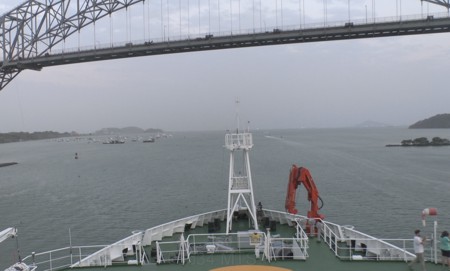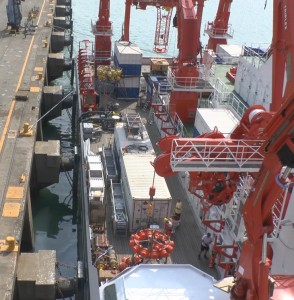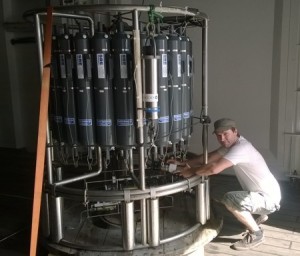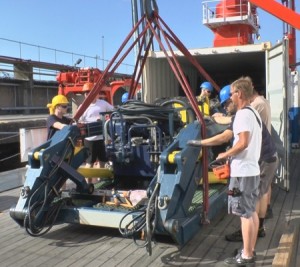Almost exactly one week ago, my colleague Tim and I started our journey to join cruise SO239 to the Mn-nodule belt in the middle of the Pacific Ocean (117W, 12N) onboard the new SONNE. We flew from Hamburg to Frankfurt and headed on to Mexico City, where we stayed the night to catch a flight on the next morning. We arrived in Panama City at around 2pm and after some immigration issues we could continue to the ship. Compared to Kiel it was very hot and humid. As usually in ports, most of the time is spent waiting for something: the crane, the agent, the container, the fork lift, … Luckily we had arrived two days before the ship was scheduled to leave and had some time left for waiting. A bit later our container arrived and was quickly unloaded. In it, there were pallets with boxes and our DOS lander. All was put on board and the boxes where distributed as well as possible. My former colleagues from NIOZ, Henko and Leon, had to wait even longer for their equipment to arrive. The problem: they did not join the cruise but needed to rig up their BOBO lander for me so that I can deploy it for 3 months.
Some last-minute instructions ended at midnight on 9th March, 5h before Henko had to head back and drive to the airport. In the end, all went well as always (? almost always). We left port at about 5pm on the 10th for another tour of waiting, this time for spare parts for the A-frame. The time was well spent as the AUV and ROV both could perform successful balancing tests and test dives while we were on anchor. The spare parts arrived at about 8pm and soon after we left Panama to steam with 12-13kn towards our working area 2300nmi away.
And here we are, still steaming (with 13.4kn even) but only 1585nmi away from the first working area, at which we will arrive in 5.5 days.
BUT today we will have our first station. We will drop the CTD to get a sound velocity profile of the top 2000m of the water column to feed it into the multibeam system to map the seafloor. At the same time, we will attach some transponders for the underwater navigation system for tests and I will add four MAPRs (small CTDs with turbidity and O2-sensors) to it, also for testing. We rented them from NOAA and I never used them before, so I want to give it a try before deploying them in the deep sea.
Well, so far so good. The CTD deployment went well, the CTD itself is working as was expected, the two attached transponders did only work partially (one worked as transponder but could not be released with Posidonia, the other was released with the deck’s unit, but didn’t work as transponder) and the MAPRs worked well, I only have to get some professional advice from our NOAA colleague if the setting ‘High Gain’ for the backscatter sensor means high or low sensitivity.
Above I used a lot of terminology that we are very familiar with but you might not be. Next time, I will try to present the different bits and pieces of equipment we have on this cruise and to keep you up to date on our scientific findings.
All the best for today, Jens




Hi Jens,
How did the small-scale disturbance experiment go in the first WA? Did you manage to figure out the right tracks without fishing out landers and thermistor chain? 😉
Good luck with the rest of the cruise!
Cheers,
Annemiek